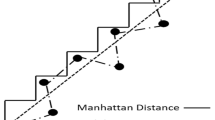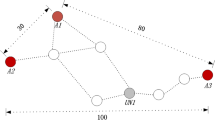Abstract
Localization is a significant challenge in the area of wireless sensor networks (WSNs). Distance Vector Hop (DV-Hop) algorithm is most preferable algorithm due to its low cost, distributed nature, and its feasibility for all kinds of sensor networks, but it suffers from high localization error. In order to reduce the problem of high localization error for 2-dimensional and 3-dimensional WSNs, two Nature Inspired Algorithm based improved variants have been proposed. The first one uses Grey-Wolf optimization (GWO-DV-Hop) to identify a better estimate of average distance per hop and second one, a weighted Grey-Wolf optimization (Weighted GWO-DV-Hop), finds average distance per hop as computed by each beacon node using grey wolf algorithm and then, a weighted approach is applied by each node to get weighted average distance per hop (weights based on distance from each beacon) so as to consider impact of all types of beacons. The results prove the superiority of proposed algorithms over traditional DV-Hop in terms of localization error.











Similar content being viewed by others
References
Rawat, P., Singh, K. D., Chaouchi, H., & Bonnin, J. M. (2014). Wireless sensor networks: A survey on recent developments and potential synergies. The Journal of Supercomputing, 68(1), 1–48.
Kaur, A., Kumar, P., & Gupta, G. P. (2017). A weighted centroid localization algorithm for randomly deployed wireless sensor networks. Journal of King Saud University-Computer and Information Sciences https://doi.org/10.1016/j.jksuci.2017.01.007.
Han, G., Xu, H., Duong, T. Q., Jiang, J., & Hara, T. (2013). Localization algorithms of wireless sensor networks: a survey. Telecommunication Systems, 52(4), 2419–2436.
Zhao, J., Xi, W., He, Y., Liu, Y., Li, X., Mo, L., et al. (2013). Localization of wireless sensor networks in the wild: Pursuit of ranging quality. IEEE/ACM Transactions on Networking, 21(1), 311–323.
Kunz, T., & Tatham, B. (2012). Localization in wireless sensor networks and anchor placement. Journal of Sensor and Actuator Networks, 1(1), 36–58.
Girod, L., Bychobvskiy, V., Elson, J., & Estrin, D. (2002). Locating tiny sensors in time and space: a case study. In Proceedings of the 2002 IEEE international conference on computer design: VLSI in computers and processors, Los Alamitos (pp. 214–219).
Harter, A., Hopper, A., Steggles, P., Ward, A., & Webster, P. (2002). The anatomy of a context-aware application. Wireless Networks, 8(2), 187–197.
Cheng, X., Thaeler, A., Xue, G., & Chen, D. (2004). TPS: a time-based positioning scheme for outdoor wireless sensor networks. In Proceedings of the 23rd IEEE annual joint conference of the ieee computer and communications societies (INFOCOM’04), Hong Kong, China, March 2004 (pp. 2685–2696).
Niculescu, D., & Nath, B. (2003). Ad hoc positioning system (APS) using AoA. In Twenty-second annual joint conference of the ieee computer and communications (Vol. 3, pp. 1734–1743). IEEE Societies.
Bulusu, N., Heidemann, J., & Estrin, D. (2000). GPS-less low cost outdoor localization for very small devices. IEEE Personal Communications Magazine, 7(5), 28–34.
Niculescu, D., & Nath, B. (2001). Ad hoc positioning system. In IEEE on global telecommunications conference (Vol. 5, pp. 2926–2931).
Nagpal, R. (1999). Organizing a global coordinate system from local information on an amorphous computer. A.I. Memo1666, MIT A.I. Laboratory.
Shang, Y., & Ruml, W. (2004). Improved MDS-based localization. In Proceedings of the IEEE Conference on Computer Communications (INFOCOM’04), Hong Kong, March 2004 (pp. 2640–2651).
He, T., Huang, C. D., Blum, B. M., Stankovic, J. A., & Abdelzaher, T. (2003). Range-free localization schemes for large scale sensor netowrks. In Proceedings of the 9th the annual international conference on mobile computing and networking (pp. 81–95). San Diego, Calif, USA: ACM.
Kaur, A., Gupta, G. P., & Kumar, P. (2017). A survey of recent developments in DV-Hop localization techniques for wireless sensor network. Journal of Telecommunication, Electronic and Computer Engineering, 9(2), 61–71.
Tomic, S., & Mezei, I. (2016). Improvements of DV-Hop localization algorithm for wireless sensor networks. Telecommunication Systems, 61(1), 93–106.
Song, G., & Tam, D. (2015). Two novel DV-Hop localization algorithms for randomly deployed wireless sensor networks. International Journal of Distributed Sensor Networks, 11(7), 187670. https://doi.org/10.1155/2015/187670.
Zhang, B., Ji, M., & Shan, L. (2012). A weighted centroid localization algorithm based on DV-hop for wireless sensor network. In Proceedings of the 8th international conference on wireless communications, networking and mobile computing, Shanghai, China (pp. 1–5).
Fang, X. (2015). Improved DV-Hop positioning algorithm based on compensation coefficient. Journal of Software Engineering, 9(3), 650–657.
Peng, B., & Li, L. (2015). An improved localization algorithm based on genetic algorithm in wireless sensor networks. Cognitive Neurodynamics, 9(2), 249–256.
Gui, L., Val, T., Wei, A., & Dalce, R. (2015). Improvement of range-free localization technology by a novel DV-hop protocol in wireless sensor networks. Ad Hoc Networks, 24, 55–73.
Shahzad, F., Sheltami, T. R., & Shakshuki, E. M. (2017). DV-maxHop: A fast and accurate range-free localization algorithm for anisotropic wireless networks. IEEE Transactions on Mobile Computing, 16(9), 2494–2505.
Wang, F., Wang, C., Wang, Z., & Zhang, X. Y. (2015). A hybrid algorithm of GA+ simplex method in the WSN localization. International Journal of Distributed Sensor Networks, 11(7), 731894.
Kumar, S., & Lobiyal, D. K. (2016). Novel DV-Hop localization algorithm for wireless sensor networks. Telecommunication Systems, 64(3), 509–524.
Mirjalili, S., Mirjalili, S. M., & Lewis, A. (2014). Grey wolf optimizer. Advances in Engineering Software, 69, 46–61.
Kaur, A., Kumar, P., & Gupta, G. P. (2016). A novel DV-Hop algorithm based on Gauss–Newton method. In IEEE international conference on parallel, distributed and grid computing (pp. 625–629).
Keshtgary, M., Fasihy, M., & Ronaghi, Z. (2011). Performance evaluation of hop-based range-free localization methods in wireless sensor networks. ISRN Communications and Networking, 2011, 485486. https://doi.org/10.5402/2011/485486.
Kulaib, A. R., Shubair, R. M., Al-Qutayri, M. A., & Ng, J. W. P. (2015). Improved DV-hop localization using node repositioning and clustering. In 2015 International conference on communications, signal processing, and their applications (ICCSPA) (pp. 1–6). IEEE.
Ping, W. Z., & Chen, X. (2015). Node localization of wireless sensor networks based on DV-hop and Steffensen iterative method. International Journal of Future Generation Communication and Networking, 8(2), 1–8.
Kumar, S., & Lobiyal, D. K. (2017). Novel DV-Hop localization algorithm for wireless sensor networks. Telecommunication Systems, 64(3), 509–524.
Cota-Ruiz, J., Rosiles, J. G., Sifuentes, E., & Rivas-Perea, P. (2012). A low-complexity geometric bilateration method for localization in wireless sensor networks and its comparison with least-squares methods. Sensors, 12(1), 839–862.
Kumar, S., & Lobiyal, D. K. (2013). Improvement over DV-Hop localization algorithm for wireless sensor networks. World Academy of Science, Engineering and Technology, 76(4), 282–293.
Ahmad, T., Li, X. J., & Seet, B. C. (2017). Parametric loop division for 3D localization in wireless sensor networks. Sensors, 17(7), 1697. https://doi.org/10.3390/s17071697.
Keshtgary, M., Fasihy, M., & Ronaghi, Z. (2011). Performance evaluation of hop-based range-free localization methods in wireless sensor networks. ISRN Communications and Networking, 2011. https://doi.org/10.5402/2011/485486.
Singh, M., & Khilar, P. M. (2016). An analytical geometric range free localization scheme based on mobile beacon points in wireless sensor network. Wireless Networks, 22(8), 2537–2550.
Author information
Authors and Affiliations
Corresponding author
Rights and permissions
About this article
Cite this article
Kaur, A., Kumar, P. & Gupta, G.P. Nature Inspired Algorithm-Based Improved Variants of DV-Hop Algorithm for Randomly Deployed 2D and 3D Wireless Sensor Networks. Wireless Pers Commun 101, 567–582 (2018). https://doi.org/10.1007/s11277-018-5704-7
Published:
Issue Date:
DOI: https://doi.org/10.1007/s11277-018-5704-7




